Abstract
In the present work, we have investigated phytochemical content, cardiovascular effect, anti-oxidant, anti-inflammation, and anti-tumor by Beta Vugaris (Beet) Root Extract Juice. It is highly abundant and is commonly known as “Cu Den” in Vietnam. Ayurvedic literature reveals that Beet Root extract has cardiovascular effect, antioxidant, anti-inflammation, and anti-tumor properties. Beta Vulgaris (Beet) root Juice Extract traditionally have been traditionally used as medicinal, nutritional and health benefits, besides its rich supply of mineral and vitamins, its antioxidant property help to prevent the formation of cancerous tumors and are therefore a powerful cancer-fighting agent. In this research articles, we discuss the biological fate of Beet Root extract juice with special emphasis on dietary inorganic nitrate in cardiovascular systems. Phytochemical analysis of Beet Root was detected by ICP-OES. Effect of Dietary Nitrate on Blood Pressure was measured Systolic Blood Pressure and Pulse Rate. The Effectiveness of Beet Root Extract on induction of cancer cell apoptosis and necrosis was measured by low and high N fertilization level. The antioxidant property of Beet Root extract was measured by using the growth medium as % of fermented juice of total weight in the wells. Betalain levels were measured by using Robust analytical HPLC-DAD-MS techniques.
Key words
beta vulgaris (beet) root, beet root juice, phytochemical, antioxidant, nitric oxide, cardiovascular effect, anti-inflammation, anti-tumor
Introduction
Beetroot (Beta Vulgaris) as a flavor agent, which includes silver beet, sugar beet, fodder beet and beet; it is a member of Chenopodiaceous family (Figure 1). Beetroot produces swollen root during growing season, and green tops. It is presently distributed over the whole world especially in South America included southern part of Mexico, India, Thailand and Vietnam; but originally from Germany. It usually grown for salad rather than for sugar production. It can be cooked, blanched, steamed or boiled. Beetroot is one of the richest dietary sources of dietary nitric oxide. It improves blood flow though the body including the brain, heart and muscles. It helps open up the cardiac vessels and allows more oxygen flow in; it also decrease the incidence of cardiovascular disease by lower both systolic and diastolic pressure mechanism.

Figure 1. Beetroot (Beta Vulgaris) as a flavor agent
In vivo, we have shown that ingestion of beetroot juice (dietary nitrate) results in increased plasma nitrite concentration. It substantially decreases blood pressure, inhibits platelet aggregation, and prevents endothelial dysfunction in all healthy patients. The study had a randomized, double blind, crossover design, the treatment periods were separated by a washout period of at least 10 days. The reduction in blood pressure continued to be observed until up to 24 hrs after the juice was consumed. Systolic blood pressure and pulse rate didn’t change significantly after dietary nitrite supplement were given. However, the diastolic blood pressure was about 4mmHg lower.
To be the most important components of diet for good health is consuming the plant products. Vegetables and fruits have been shown to have nutritional and therapeutic effect. Phytochemical from Beetroot juice have been found to be responsible for such effects includes vitamins, mineral, and therapeutic effect. Phenolic compounds such as Flanovoids, phenolic acids, and phenolic amides, Betanin Isobetanin, Vulgaxanthin I &II. They all exhibit anti-ischemic effect, anti-inflammation effect, antioxidant, and anticancer effect.
This work investigated some physicochemical properties of Beetroot juice. In Southern California, where we have similar tropical weather country like Asia, it is also the best place in US to grow Beetroot trees. In Southern California, USA with the help of Herbalife Nutritional Translational Research and Clinical Pharmacology, we evaluated the Beetroot juice. Beetroot was destalked, washed, sided into thin piece, and grated into mash. Juice extracted of mash to water, and sugar syrup added. Finally, it is pasteurized at 85 degree Celsius, cooled at room temperature.
Then, this beetroot juice was given to healthy volunteer patient for measure blood pressure in New York, Ohio State and Herbalife Employee in Southern California, USA. They were also given to solid tumor cancer patients in New York, Ohio State, USA and HCM City, Vietnam for anti-tumor effect evaluation. Data have been measured and analyzed by statistics, lab analyst. These researches have been taken place places in New York, Ohio, Southern California, USA and HCM City, Vietnam from Jan 2016 to June 2018.
Materials and methods
Mineral component of beetroot juice
Oven drying method significantly increased the potassium value of the juice to 875.mg compared to the fresh juice sample (230mg) with the least amount of potassium value and showed significant difference (p>0.05) in all the juice samples. The fresh juice had the highest iron content (21mg); followed by oven dried sample with 16mg of iron and sun dried 15mg of iron. The calcium content of the juice isn’t affected by the sun drying method. With drying method, Magnesium value within the juices was increased; Oven dried sample significantly increased to 102mg, sun dried sampled to 51mg compared to the fresh juice with Magnesium value of 34mg. The result showed that by the method of drying as depicted in Table 1, the nitrate content of juice sample was not influenced.
Table 1. Mineral components of the beetroot juice
Mineral Components (mg) |
Fresh Juice Sample |
Sun dried Juice Sample |
Oven Derived Juice sample |
Nitrate |
0.04 |
0.04 |
0.04 |
Potassium |
230 |
327 |
875 |
Iron |
20 |
15 |
16 |
Calcium |
3.1 |
3.6 |
3.9 |
Magnesium |
34 |
51 |
100 |
Dietary nitrate lowers BP
There were no differences in BP between the 2 groups during the hour before ingestion of beetroot juice or water. BP began to decrease from1 hour after ingestion of juice compared to the water control (Figure 2). The peak difference in systolic BP was achieved at 2.5 hours after ingestion with a drop a 11+/-2mm Hg (P<0.01, whereas the peak differences in diastolic BP and MAP were seen at 3 hours after ingestion it changes of 9+/-2mm Hg and 8.2 +/-mmHg, respectively (both P<0.01), (Figure 2). At 2.4 hours, systolic BP was 4.5mm Hg lower with beetroot juice than water. However, systolic BP was significantly reduced by approximately 6mm Hg at 24 hours after beetroot juice ingestion compared to -1 hour. The mean heart rate was not significantly altered over 1 to 6 hours period after beetroot juice or water ingestion.
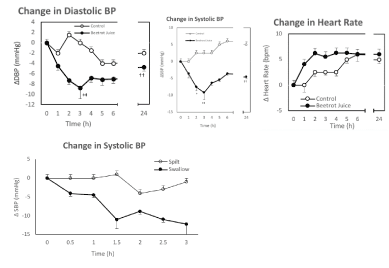
Figure 2. The effect of beetroot juice on the change from baseline in (a) diastolic BP, (b) systolic BP, (c) heart rate, (d) effect of spitting vs. swallowing of saliva on the changes in systolic BP after beetroot juice. +P<0.05, ++P<0.01, +++P<0.001
Mechanism of beetroot juice metabolism
After ingestion of beetroot juice plasma juice plasma nitrate concentration increased rapidly (within 30 minutes), peaking at 1.5 hours. Up to 25% of plasma nitrate is also excreted in the saliva [1,2], but the vast majority of absorbed inorganic nitrate is ultimately excreted in the urine. The result is the provision of substrate for the nitrate reductases expressed by bacteria that colonize the dorsal surface of the tongue, resulting in the reduction of nitrate to nitrite. This nitrite is swallowed and in the acidic environment of the stomach is then reduced to Nitric Oxide (NO) or reenters the circulation as nitrite (Figure 3). Nitrite mediates this decrease in BP, recent evidence demonstrates that nitrite is potent vasodilator in human [3], and it is likely that such vasodilator activity underlies the BP effects evidenced. This activity of nitrite has been attributed to its chemical reduction to the potent vasodilator Nitric Oxide (NO). That nitrite derived from dietary nitrate was a substrate for Nitric Oxide Synthase (NOS)-independent production of Nitric Oxide (NO) in the acidic conditions of the human GI tract [4,5].
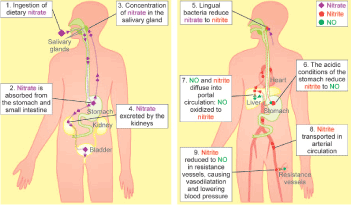
Figure 3. The metabolism of dietary nitrate, derived from consuming beetroot juice
(L) Panel: systemically absorbed nitrate is concentrated 10 xs in the salivary glands and undergoes an entero-salivary circulation, where it is reduced to nitrite by bacterial nitrate reductases on the dorsal surface of the tongue, and swallowed into the stomach providing a source of systemically available nitrite/NO.
(R) Panel: Nitrite is transported in the arterial circulation to resistance vessels, where lower oxygen tension favors the reduction of nitrite to Nitric Oxide, which causing vasodilatation with conconsequent lowering of Blood Pressure.
Volunteers: the inclusion criteria were healthy volunteer aged from 18 to 45, screened by medical assistant. The exclusion criteria were a history of any serious illnesses, including infectious diseases or systemic medications (oral contraceptive pills are included) and smoking. Volunteers were asked to refrain from any caffeine-containing foods or drinks with a high nitrate content (beetroot, green leafy vegetables) for 12 hours prior to the study and were fasting on the morning prior to drink Beetroots juice.
BP measurement: BP were taken according to the standard protocol using an automated BP Omron 7 series with the subject seated; at least three BP measurements were taken at each time point and the mean of all three reading was used.
Phytochemical compounds of Beetroot and its property of antioxidant, anti-inflammation and anticancer:
Beetroot is a rich source of phytochemical compounds that includes ascorbic acid, cartotenoids, phenolic acids and flavonoids [6-8]. Betalains [9,10] is one of a highly bioactive pigment has been found in Beetroot. Betalains is having high antioxidant and anti-inflammatory capabilities and variety in vivo human. It has a wonderful role for beetroot in clinical pathologies characterized by oxidative stress and chronic inflammation such as liver disease, arthritis and even cancer (Figure 4).
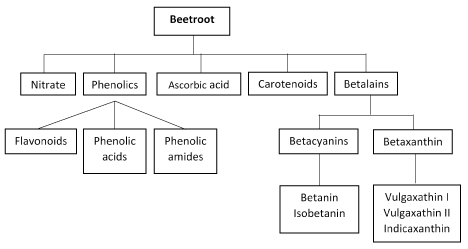
Figure 4. Potentially bioactive compounds in beetroot
The betanin, the most abundant betalain found in beetroot (300-600 mg.kg-1), was the most effective inhibitor of lipid peroxidation. Betalains’s high antioxidant activity appeared to stem from its exceptional electron donating capacity, and its abilities to defuse highly reactive radicals targeting at cell membranes [11]. Beetroot also contains several highly bioactive phenolics, such as caffeic acid, pedicatechin and rutin which are also known to be excellent antioxidant [12,13]. Nitrite and other Nitric Oxide (NO), as well as beetroot have been shown to suppress radical formation and directly scavenge potentially damaging Reactive Oxygen and Nitrogen Species (RONS) (i.e. UV radiation, xenobiotics) such as hydrogen peroxide and superoxide suggesting nitrate may also exhibit antioxidant effects [14-16]. Beetroot juices inhibited in vivo formation in the 2,2-diphenyl-1—picrylhydrazyl (DPPH). DPPH is mainly found in ovary cancer, nasal, and paranasal sinus cancer. Interestingly, the antioxidant capacity of beetroot juice in DPPH was far greater than more well-known vegetable juices, such as carrot, tomato, and fruit juices such as pineapple and orange juice (Figure 5).
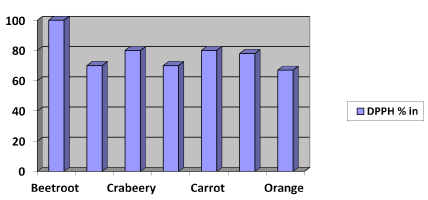
Figure 5. A comparison of the 2,2-diphenyl-1-picrylhydrazyl (DPPH) inhibiting capacity (%) exhibited by different fruit vs. Beetroot juice in oncology patients
Beetroot extracts and Betalains have emerged as potent anti-inflammatory agents. It is interfering with pro-inflammatory signaling cascades. The most important of these is the Nuclear Factor-Kappa B (NF-kB) cascade, it directly activates and transcribes most gene targets that regulate and amplify the inflammatory response (i.e, chemokines, cytokines, phagocytic and apoptotic cell) [17]. As the result, NF-kB activity plays a central role in the inflammatory processes that manifest in chronic disease. Betalains have also been shown to markedly suppress cyclooxygenase-2 (COX-2) expression, which is an important precursor molecule for pro-inflammatory arachiodonic acid metabolites known as prostaglandins [18,19]. Previous study [20] also found higher concentration of betalains compared to phenolic compounds. This raises the possibility question for pharmaceutical industry that betalains rich beetroot supplements in sufficient doses could exhibit anti-inflammatory effects to newly promised synthetic drugs (Figure 6).
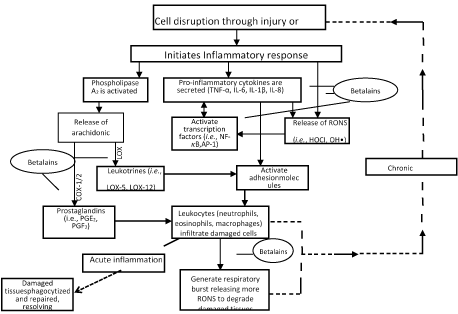
Figure 6. Illustration of the inflammatory cascade in response to cellular attack and possible pathways where betalains compound may exhibit inhibitory effects
Interestingly, therapeutic administration of Beetroot juice (betalain rich) alleviated inflammation and pain in osteoarthritis patients. After 10 days continuously drinking 500mL a day, the pro-inflammatory cytokines, tumor necrosis factor-alpha (TNF-alpha) and interleukin-6 (INL-6), had decreased from 40% to 9%, and from 29% to 20%, respectively.
Vitamin C and phenolic compounds
The vitamin C content was measured according to the America Standard. The method for measuring Vitamin C content consists of the oxidation of L-ascorbic acid (ASC) to dehydroxyascorbic (DHA) acid in an acidic environment using the blue dye 2.6-dichlorophenyloindophenol. Phenolic compounds were determined following the method described by Hallmann [21], using high-performance liquid chromatography (HPLC). The samples were then centrifuged at 3920 x g. 1mL extract was collected from the test tube and re-centrifuged at 22.8x g .500mmL extract was transferred to HPLC vials and analyzed.
Induction of cancer cell apoptosis and necrosis
The impact of the fermented beetroot juice extract on ovary cancer cell line is showed on Table 2. The extracts of organic beetroot juices induced higher levels of late apoptosis and necrosis in Ovary Cancer cells in relation to the conventional juice extracts, and beetroots grown with a low level of nitrogen fertilization (LNF). The highest concentration of extract induced significantly greater early apoptosis in relation to the other concentrations. At the same time, it activated the lowest level of late apoptosis and necrosis in Ovary Cancer.
Table 2. The effect of organic (ORG) and conventional (CONV) growing systems using low (LNF) and high (HFN) N Fertilization level, concentrations of extracts of fermented beetroot juice effect on the early, late apoptosis, necrosis and living cells
Factor |
Early Apoptosis |
Late Apoptosis |
Necrosis |
Living Cells |
ORG LNF level |
56.2+/-11.0a |
265.2+/-94.0.b |
215+/-42.2b |
90.2+/-4.1a |
CONV LNF level |
120.2+/-25.7b |
109.2+/-58.4a |
82.8+/-25.2a |
107.4+/-6.2b |
ORG HNF level |
74.2+/-14.2a |
256.2+/-115.4a |
200.2+/-63.2a |
92.4+/-8.2a |
Extract (ORG+CONV) 0.025% |
62.2+/-15.1a |
269.2+/-76.1b |
175.2+/-361.2b |
95.1+/-3.1a |
Extract (ORG+CONV) 0.0125% |
79.2+/-13.2a |
267.2+/-101.6b |
206.2+/-60.1b |
90.2+/-6.2a |
The study of apoptosis was conducted by marking with annexin V and propidine iodide, which enables the identification of cells in the early and late phases of apoptosis and necrosis. Application of annexin V joined with Fluorochrome can detect surface apoptosis and necrosis using a flow cytometer (FACSCibur). The culture was kept for 3 days on 24 well culture plate, 100 thousand cells per well (Table 3).
Table 3. The correlation relations between Vitamin C, Phenolic Acid vs. Ovary, Oral and Nasal Carcinoma Cancer cell
Compounds |
Extract Concentration |
Early Apoptosis |
Late Apoptosis |
Necrosis |
Living Cells |
Organic Vitamin C |
0.025% |
+0.6 |
NS |
NS |
NS |
Flavonoids |
0.05% |
NS |
NS |
+0.65 |
NS |
Phenolic Acids |
0.05% |
NS |
+0.95 |
+0.9 |
-0.9 |
Betanin-3-O-glucoside |
0.025% |
NS |
+0.7 |
NS |
NS |
Betanin-3-O-Glucoside Conventional Juice |
0.0125% |
NS |
-0.7 |
NS |
-0.7 |
Thus, it demonstrated that extracts of beetroot juices made from ORG beetroots caused a stronger effect on late apoptosis and necrosis in these tumor cells than those from CONV one, it proved betacyanins hampered cancer processes
Analysis of correlation between the content of antioxidants in beetroot juice and the response of Ovary and Nasal Carcinoma
A significant positive correlation between the content of Vitamin C in ORG juices and early apoptosis was found for a concentration of 0.025% extract. The positive correlation between betanin-3-O-glucoside content in ORG fermented juice extracts and late apoptosis was recorded in extract of 0.025% concentration. There is a negative correlation was noted between the betanin-3-O-glucoside content in CONV juice and late apoptosis of Ovary cell for the extract of 0.0125% concentration Table 2.
Conclusion
Beetroot (Beta Vulgaris) juice can mediate cardiology effect, anti-oxidant, anti-inflammation, and anti-tumor, results recommend that Beetroot juice can provide the treatment for angina, pain management, as well as chemotherapeutic agents. The result of different studies indicates its need for implementation for therapeutic advantage for the near future.
Acknowledgement
We are grateful to all biostatistician for all the data analysis at Herbalife Pharmaceutical Company for lab data. Grateful thank to all staff members of Herbalife Pharmaceutical to allow us for using lab. Grateful thank to all staff members of Internal Medicine and Psychiatry House staff physician at Bronx-Lebanon Hospital, NY. Grateful thank to all staffs members physician from Department of Otolaryngology, Department of Obstetrics/Gynecology at The University of Medicine and Pharmacy at HCM City, HCM, Vietnam; Department of Biological Chemistry and Pharmacology, Department of Family Medicine at The Ohio State University, College of Medicine, Columbus, OH, USA; all physician staff at Nephrology Division of Internal Medicine Department at Albany University Medical Center, Albany, New York, USA; all cardiology staff physician of Department of Cardiology at Pham Ngoc Thach University of Medicine, HCM City, Vietnam; Staff Cardiology physician at Phuong Chau International Hospital, Can Tho City, Vietnam; Chair of Preventative Medicine Department at CDU/UCLA School of Medicine, Los Angeles, CA, USA. Grateful thanks to staffs members of Pathology Lab of Los Angeles County Hospital and Keck University of Southern California, Los Angeles, USA. IRB Review approved by New York, Ohio, USA. IRB Rev ew approved by Vietnam Board of Medicine and Pharmacy since the article related to botanical pharmacology and pharmacogenomic.
References
- Lundberg JO, Weitzberg E, Cole JA, Benjamin N (2004) Nitrate, bacteria and human health. Nat Rev Microbiol 2: 593-602. [Crossref]
- Tannenbaum S, Weisman M, Fett D (1976) The effect of nitrate intake on nitrite formation in human saliva. Food and cosmetics toxicology 14: 549-552.
- Cosby K, Partovi KS, Crawford JH, Patel RP, Reiter CD, Martyr S, et al. (2003) Nitrite reduction to nitric oxide by deoxyhemoglobin vasodilates the human circulation. Nature medicine 9: 1498-1505.
- Benjamin N, O'Driscoll F, Dougall H, Duncan C, Smith L, et al. (1994) Stomach NO synthesis. Nature 368: 502 [Crossref]
- Lundberg J, Weitzberg E, Lundberg J, Alving K (1994) Intragastric nitric oxide production in humans: measurements in expelled air. Gut 35: 1543-1546.
- Georgiev VG, Weber J, Kneschke E-M, Denev PN, Bley T, et al. (2010) Antioxidant activity and phenolic content of betalain extracts from intact plants and hairy root cultures of the red beetroot Beta vulgaris cv. Detroit dark red. Plant Foods for Human Nutrition 65: 105-111.
- Kujala TS, Vienola MS, Klika KD, Loponen JM, Pihlaja K, et al. (2002) Betalain and phenolic compositions of four beetroot (Beta vulgaris) cultivars. European Food Research and Technology 214: 505-510.
- Wootton-Beard PC, Ryan L (2011) A beetroot juice shot is a significant and convenient source of bioaccessible antioxidants. Journal of functional foods 3: 329-334.
- Lee CH, Wettasinghe M, Bolling BW, Ji LL, Parkin KL (2005) Betalains, phase II enzyme-inducing components from red beetroot (Beta vulgaris L.) extracts. Nutr Cancer 53: 91-103. [Crossref]
- Vulic JJ, Cebovic TN, Canadanovic-Brunet JM, Cetkovic GS, Canadanovic VM, Djilas SM, et al. (2014) In vivo and in vitro antioxidant effects of beetroot pomace extracts.Journal of Functional Foods 2014, 6: 168-175.
- Kanner J, Harel S, Granit R (2001) Betalains a new class of dietary cationized antioxidants. Journal of Agricultural and Food chemistry 49: 5178-5185.
- Frank T, Stintzing FC, Carle R, Bitsch I, Quaas D, Straß G, et al. (2005) Urinary pharmacokinetics of betalains following consumption of red beet juice in healthy humans. Pharmacological research 52: 290-297.
- Manach C, Williamson G, Morand C, Scalbert A, Rémésy C (2005) Bioavailability and bio efficacy of polyphenols in humans. I. Review of 97 bioavailability studies. The American journal of clinical nutrition 81: 230S-242S.
- Lundberg JO, Carlstrom M, Larsen FJ, Weitzberg E (2010) Roles of dietary inorganic nitrate in cardiovascular health and disease. Cardiovascular research 89: 525-532.
- Wink DA, Hines HB, Cheng RY, Switzer CH, Flores-Santana W, Vitek MP, et al. (2011) Nitric oxide and redox mechanisms in the immune response. Journal of leukocyte biology 89: 873-891.
- Wink DA, Miranda KM, Espey MG, Pluta RM, Hewett SJ, et al. (2001) Mechanisms of the antioxidant effects of nitric oxide. Antioxid Redox Signal 3: 203-213. [Crossref]
- Baker RG, Hayden MS, Ghosh S (2011) NF-IºB, inflammation, and metabolic disease. Cell Metab 13: 11-22. [Crossref]
- Vidal PJ, Lopez-Nicolas JM, Gandia-Herrero F, Garcia-Carmona F (2014) Inactivation of lipoxygenase and cyclooxygenase by natural betalains and semi-synthetic analogues. Food chemistry 154: 246-254.
- Zielinska-Przyjemska M, Olejnik A, Dobrowolska-Zachwieja A, Grajek W (2009) In vitro effects of beetroot juice and chips on oxidative metabolism and apoptosis in neutrophils from obese individuals. Phytotherapy Research 23: 49-55.
- Reddy MK, Alexander-Lindo RL, Nair MG (2005) Relative inhibition of lipid peroxidation, cyclooxygenase enzymes, and human tumor cell proliferation by natural food colors. Journal of Agricultural and Food Chemistry 53: 9268-9273.
- Hallmann E (2012) The influence of organic and conventional cultivation systems on the nutritional value and content of bioactive compounds in selected tomato types. Journal of the Science of Food and Agriculture 92: 2840-2848.






